Dragontail - Serpentine Arête
Who: Emily and Dave
When: July 1-3, 2002
We arrived at the Leavenworth Ranger station early Monday morning with the hopes of getting a permit to camp at Colchuck Lake in the Enchantments. It was completely sunny when we arrived, but only a handful of people showed up for permits. We signed up and paid our fee ($3 a day?) then promptly headed off for a leisurely breakfast at Krystalls.
We had all day to hike what the description called a 3 hour approach, so we set off from the Stuart Lake trailhead around 10 a.m. Sunny and warm hiking lead us through the beautiful low lands of the Mountaineer Creek Drainage.

Mountaineer Creek.
After two hours of hiking we came to the shores of Colchuck Lake. The view was beautiful with rugged granite peaks all around soaring up out of forest and glaciers. Another half hours walk along the lake brought us to our camp along the South shore of the lake.
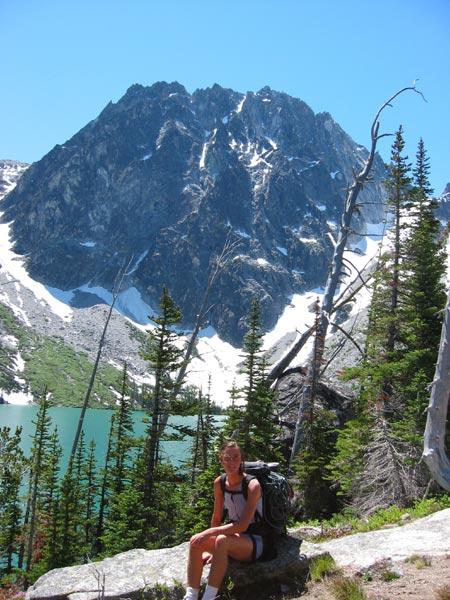
Emily, Colchuck Lake, and Dragontail Peak.
We setup camp and wondered if we shouldn't be camping higher on the moraine above us. We were only 1,300 vertical feet below the base of the route, but our wind protected camp with fresh running water persuaded us to stay. So we just spent a lazy afternoon down by the lake taking in the sun and trying not to go to sleep! I tried to keep myself awake by trying to point out the specifics of the lower half of our climb: the Serpentine Arete.
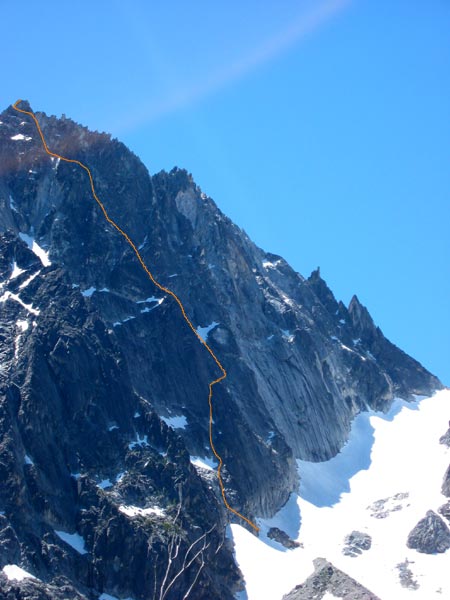
The Serpentine Arete on Dragontail's massive NW face.
We weren't quite sure when to get up the next day. Our description mentioned that the route could take 6-10 hours, and the descent 3-4. With the long days, a 5:30 a.m. wake-up seemed appropriate. However, I had just read about a party the previous weekend that woke up at the same time and had not finished the route before dark! Eventually we decided it was not worth getting up earlier and climbing in the bitter cold of the early morning, so 5:30 it was.
Having plenty of time to sleep was nice, and we both got more sleep that night than we had for the several days prior. I was actually awake and looking out the "window" of the tent when the alarm went off. Sunny skies greeted us as we began our climb up the moraine at 6 a.m.
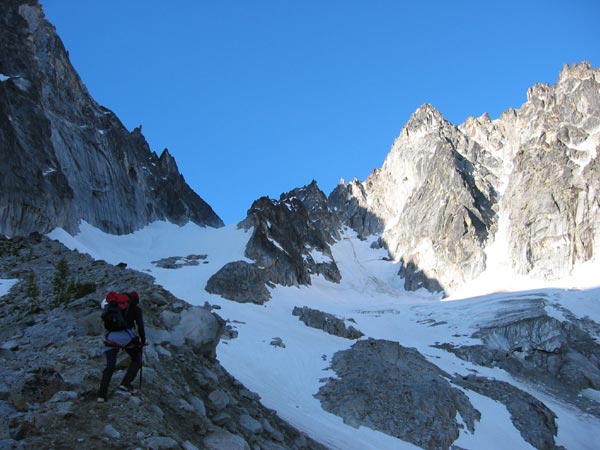
Emily hiking up the moraine to the base of the Colchuck Glacier.
The snow had frozen overnight and was incredibly hard. We had only brought ice axes, hoping to carry as little as possible over the route. I began to nervously eye the short but steep dome of snow that leads to the base of the route. Emily and I chopped steps across the snow to a large rock island below the route where we roped up.

The route starts on ledges near the highest snow on the right.
The final steep snow to the moat crossing was rock solid, so I chopped steps along an old track. As I chopped the very last step to get myself over the moat lip, my ice axe grazed off the snow and stuck my knee with full force! Shit! I let out a hell of a yell, eventually got my composure back, and flopped ungracefully into the moat. My knee seemed to be doing ok by the time Emily joined me, so we racked up and set off on a running belay at 8 a.m.

Climbing easy but exposed rock low on the route. Photo by: Emily Lang
After two running belay "pitches" we were at the base of the first true 5th class pitch. We setup the belay at a small tree and I lead off on a series of ledges that traversed into the corner that leads to the tower above. Near 50 meters I stopped on a nice ledge and brought Emily up. The next pitch was more climbing in the corner with a 5.7 move to surmount a flake. This lead to another, larger ledge which we traversed to the end, and then over 3rd class ground around the tower that leans against the face. This brought us to the first of the 5.8 crux pitches.
After giving my knuckles a good scraping while setting a belay, I set off on the marvelous crack. Steep and exposed climbing on excellent rock brought me to a small belay stance off a large horn at about half rope.
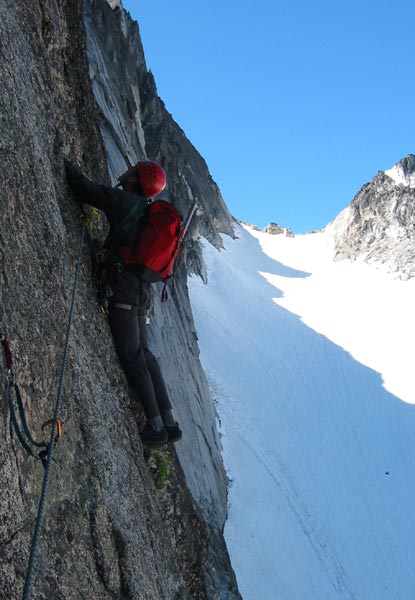
Dave heads up the first 5.8 pitch. Photo by: Emily Lang
The next pitch looked to be more steep crack climbing. Excellent! I lead up some double cracks with good stemming. More cracks and dihedrals followed up to an airy belay seat at about half rope. At this point I began to wish we had brought a larger rack, for many short pitches could really slow us down. We had 6 cams, a big hex, a set of nuts and 10 singles. After belay gear and slings, this didn't leave me a whole lot of gear! Luckily these pitches broke themselves into short pitches nicely.
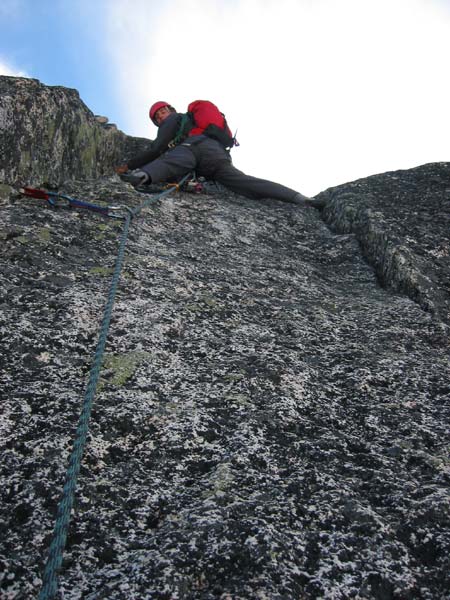
The nice double cracks on the second crux pitch. Photo by: Emily Lang
The climbing eased off a bit as we began climbing a large right facing corner. The next pitch was more enjoyable with steep crack and face climbing that eventually lead up through some chimneys to a large ledge. I was able to run it out a bit on this pitch and stretch the rope a full 50 meters.
The next pitch started with a easier-than-it-looks chimney, then lead up through sharp flakes and easier climbing to a small notch in the ridge. We had been making pretty good time so far, having climbed two running belays and six fixed pitches in six and a half hours.
The description mentioned that the next 8 pitches had 3rd to mid-5th class climbing. Hmm, running belay or fix pitches? There is nothing more time consuming than switching back and forth. We decided to running belay some, and eventually we got into a good system that worked with the ridge crest. With notches every two pitches or so, the first 25-40 meters would be easier ground, followed with low to mid fifth steps until the next notch. By stretching pitches with running belays, and some fixed pitches, we were able to climb this long and more moderate section of the route pretty efficiently.

Steep but moderate rock on the upper reaches of the arete. Photo by: Emily
Lang

Dave reaches yet another notch! Colchuck lake gets farther and farther
away.
Photo by: Emily Lang
The descriptions mention that there is a ton of loose rock, but this didn't really seem to be a problem within our party of two. We managed to knock loose very little rock. However, I wouldn't want to risk climbing below another party with such potential.
Somewhere around the equivalent of 13 pitches from the first 5th class pitch, the arete eases off in angle and the summit comes into view. We shortened the rope to 25 meters and set off on more running belays. We stayed mostly right on the crest until an obvious traverse right across easy ledges lead to a licheny wall directly below the summit tower. Low 5th class climbing lead up good cracks with some looseness to a ledge belay.

The rock eases, and the summit comes into view high on the Serpentine
Arete.
Photo by: Emily Lang
Now at the base of the summit tower, one can either climb a 5.7 route directly to the summit, or make a very short traverse left on 4th class ground to the ridge crest. The rock above looked time consuming (though filled with sweet looking cracks!), so we opted for the easy detour to the ridge crest and then up towards the summit. We were both on top 10 minutes later totally relishing in the beauty of the area and in our accomplishment on such a fine route!
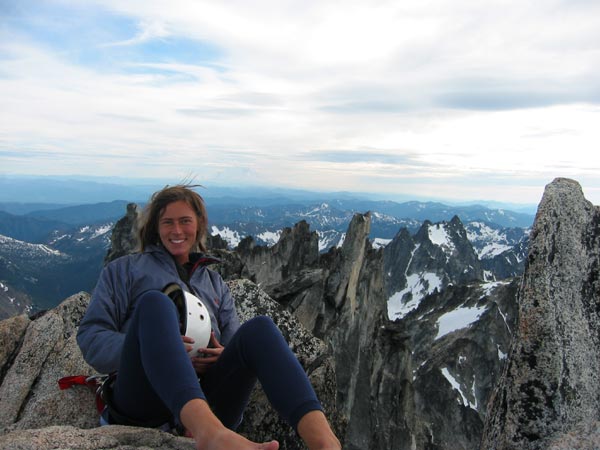
Emily on the summit of Dragontail Peak.
It was 5:45 p.m., 9 hours and 45 minutes from the base of the route. We enjoyed a bite to eat at a nice bivi spot just below the top, and then walked down towards the top of the snowfield on the back side of Dragontail. Good snow conditions brought us down to Asgard pass pretty quickly. Then began the arduous task of following steep, sandy and rocky trails back down towards the lake.
We reached camp at 9 p.m. and decided that instead of hiking out in the dark with one headlamp, we would spend another night at the lake. Though we hadn't planned food for an extra night, we got by alright on extra cashews and energy bars. The next morning saw us up early, and we chatted with a guy who was hiking around in the area. As he left he said, "Enjoy your breakfast!" We would have, that is, if we'd had any food left! A forced march then ensued back to the nearest food dispensary!
The Serpentine Arete is an excellent climb with pitch after pitch of solid and enjoyable climbing on a large alpine wall. I would recommend to bring lots of protection in the small to medium (2") range, preferably in the form of tri-cams and friends because so many of the cracks that appeared were either parallel or flared poorly for chocks. We had a #9 hex which was very nice to have, but you wouldn't need anything bigger. Go get it!